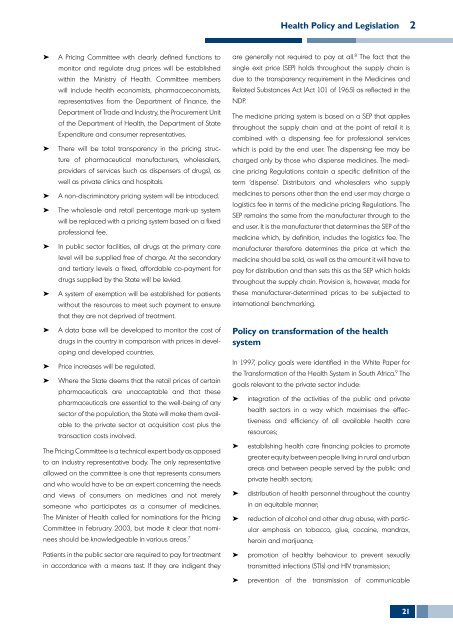SAHR 2007 - Health Systems Trust
SAHR 2007 - Health Systems Trust
SAHR 2007 - Health Systems Trust
You also want an ePaper? Increase the reach of your titles
YUMPU automatically turns print PDFs into web optimized ePapers that Google loves.
<strong>Health</strong> Policy and Legislation 2<br />
➤ A Pricing Committee with clearly defined functions to<br />
monitor and regulate drug prices will be established<br />
within the Ministry of <strong>Health</strong>. Committee members<br />
will include health economists, pharmacoeconomists,<br />
representatives from the Department of Finance, the<br />
Department of Trade and Industry, the Procurement Unit<br />
of the Department of <strong>Health</strong>, the Department of State<br />
Expenditure and consumer representatives.<br />
➤ There will be total transparency in the pricing structure<br />
of pharmaceutical manufacturers, wholesalers,<br />
providers of services (such as dispensers of drugs), as<br />
well as private clinics and hospitals.<br />
➤ A non-discriminatory pricing system will be introduced.<br />
➤ The wholesale and retail percentage mark-up system<br />
will be replaced with a pricing system based on a fixed<br />
professional fee.<br />
➤ In public sector facilities, all drugs at the primary care<br />
level will be supplied free of charge. At the secondary<br />
and tertiary levels a fixed, affordable co-payment for<br />
drugs supplied by the State will be levied.<br />
➤ A system of exemption will be established for patients<br />
without the resources to meet such payment to ensure<br />
that they are not deprived of treatment.<br />
➤ A data base will be developed to monitor the cost of<br />
drugs in the country in comparison with prices in developing<br />
and developed countries.<br />
➤ Price increases will be regulated.<br />
➤ Where the State deems that the retail prices of certain<br />
pharmaceuticals are unacceptable and that these<br />
pharmaceuticals are essential to the well-being of any<br />
sector of the population, the State will make them available<br />
to the private sector at acquisition cost plus the<br />
transaction costs involved.<br />
The Pricing Committee is a technical expert body as opposed<br />
to an industry representative body. The only representative<br />
allowed on the committee is one that represents consumers<br />
and who would have to be an expert concerning the needs<br />
and views of consumers on medicines and not merely<br />
someone who participates as a consumer of medicines.<br />
The Minister of <strong>Health</strong> called for nominations for the Pricing<br />
Committee in February 2003, but made it clear that nominees<br />
should be knowledgeable in various areas. 7<br />
are generally not required to pay at all. 8 The fact that the<br />
single exit price (SEP) holds throughout the supply chain is<br />
due to the transparency requirement in the Medicines and<br />
Related Substances Act (Act 101 of 1965) as reflected in the<br />
NDP.<br />
The medicine pricing system is based on a SEP that applies<br />
throughout the supply chain and at the point of retail it is<br />
combined with a dispensing fee for professional services<br />
which is paid by the end user. The dispensing fee may be<br />
charged only by those who dispense medicines. The medicine<br />
pricing Regulations contain a specific definition of the<br />
term ‘dispense’. Distributors and wholesalers who supply<br />
medicines to persons other than the end user may charge a<br />
logistics fee in terms of the medicine pricing Regulations. The<br />
SEP remains the same from the manufacturer through to the<br />
end user. It is the manufacturer that determines the SEP of the<br />
medicine which, by definition, includes the logistics fee. The<br />
manufacturer therefore determines the price at which the<br />
medicine should be sold, as well as the amount it will have to<br />
pay for distribution and then sets this as the SEP which holds<br />
throughout the supply chain. Provision is, however, made for<br />
these manufacturer-determined prices to be subjected to<br />
international benchmarking.<br />
Policy on transformation of the health<br />
system<br />
In 1997, policy goals were identified in the White Paper for<br />
the Transformation of the <strong>Health</strong> System in South Africa. 9 The<br />
goals relevant to the private sector include:<br />
➤<br />
➤<br />
➤<br />
➤<br />
integration of the activities of the public and private<br />
health sectors in a way which maximises the effectiveness<br />
and efficiency of all available health care<br />
resources;<br />
establishing health care financing policies to promote<br />
greater equity between people living in rural and urban<br />
areas and between people served by the public and<br />
private health sectors;<br />
distribution of health personnel throughout the country<br />
in an equitable manner;<br />
reduction of alcohol and other drug abuse, with particular<br />
emphasis on tobacco, glue, cocaine, mandrax,<br />
heroin and marijuana;<br />
Patients in the public sector are required to pay for treatment<br />
in accordance with a means test. If they are indigent they<br />
➤<br />
➤<br />
promotion of healthy behaviour to prevent sexually<br />
transmitted infections (STIs) and HIV transmission;<br />
prevention of the transmission of communicable<br />
21
















